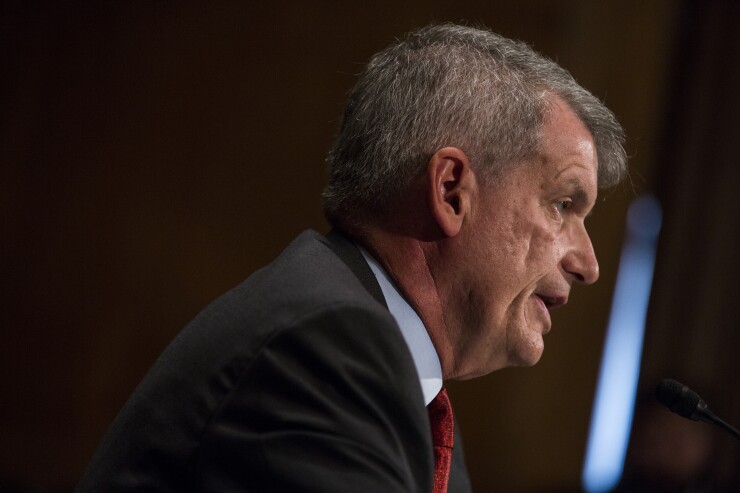Over the past year, as business lending has remained stuck in the doldrums, bankers have largely
So it stands to reason that, with Congress
Speaking at an industry conference in New York, PNC Financial Services Group CEO Bill Demchak threw cold water on the idea that a tax overhaul will unleash a wave of pent-up loan demand.
“I don’t know that there’s going to be a pickup in growth,” Demchak said.

Provisions in the tax bill to enhance the deduction for capital expenditures would likely encourage companies to invest and borrow more, Demchak said, but it’s “wildly optimistic” to assume that companies are simply standing on the sidelines, waiting for Congress to act before they decide to do so.
“For me to say, yes, that’s true, then I’d also have to say that I think [gross domestic product] is going to be 5% next year, and I don’t think that’s going to be the case,” Demchak said.
Throughout the conference, which was sponsored by Goldman Sachs, several big-bank executives — from JPMorgan Chase, Wells Fargo and other companies — said that the looming reduction in corporate rates would likely boost business confidence. Under the version of the tax bill passed by the Senate on Friday, the corporate rate would fall to 20% from 35% in 2018.
Still, some executives acknowledged that it will take more than a tax cut to boost commercial lending. Wells CEO Tim Sloan, for instance, said that higher interest rates will have a bigger impact on loan growth, encouraging businesses to take out bank loans instead of refinancing debt in the capital markets.
“Corporate [chief financial officers] and treasurers did a smart thing in the second and third quarter,” Sloan said. “They looked at where rates were and said, 'This is probably the lowest period we’re going to see in our lives, let’s take advantage of it.'”

Over the past year, the pace of lending to businesses has steadily decelerated. During the third quarter,
Pittsburgh-based PNC has been
Officials at Minneapolis-based U.S. Bancorp said they expect loan growth to remain flat compared with the third quarter, at just under 1%.
The House and Senate have passed different versions of tax reform over the past month. They are expected to iron out the differences in a conference committee in the coming coming weeks, with final passage expected before the end of the year.
Over the weekend, President Trump suggested that the corporate rate may increase to 22% as Republican leaders negotiate the final bill.
To be sure, some big-bank chiefs were upbeat about the prospects for lending growth next year, during the industry conference Tuesday.
Executives at U.S. Bancorp said that provisions in the tax bill related to accelerated depreciation will likely give customers the nudge they need to borrow more.
“Uncertainty around tax policy has caused a little bit of a wait and see,” said U.S. Bancorp CEO Andy Cecere. “Once that clarity comes in, I think there’s going to be more activity.”
Brian Moynihan, CEO of Bank of America, agreed. “I think it’ll unleash activity, no question,” he said.
The likely reduction in corporate taxes, of course, would be a boon to the bottom lines of banks themselves. But even on that count the tax overhaul could cause a few headaches.

If the tax overhaul is signed into law this year, JPMorgan Chase could take a hit of about $2 billion during the fourth quarter, due an adjustment for unremitted overseas earnings, according to Chief Financial Officer Marianne Lake.
Over time, however, the New York megabank would likely reinvest its tax savings into product development, and also look at ways to provide “better pricing” to customers, Lake said.
“We’re not looking for a windfall gain to hit our bottom line and stick there in totality,” Lake said.
In addition to the commentary on corporate taxes, executives at the conference also said they remain optimistic about the potential for regulatory relief and lower compliance costs in the months ahead.
Grayson Hall, CEO of Regions Financial in Birmingham, Ala., said the company was encouraged by an effort in the Senate to lift the threshold for systemically important financial institutions to $250 billion from $50 billion. Regions, which has $122.5 billion in assets, would benefit from the legislation.
“We think it helps our business be more flexible and dynamic in the way we manage capital and the way we manage liquidity,” Hall said.
BB&T CEO Kelly King expressed skepticism that Congress will succeed in lifting the SIFI threshold. Under the Senate bill, the $214.8 billion-asset BB&T would fall just shy of the SIFI mark.
“I don’t think it’s highly likely that the $250 billion bright-line mark will pass,” King said, describing the increased threshold as “irrelevant” to the Winston-Salem, N.C. company.
Big-bank executives, meanwhile, said the recent changing of the guard among Washington regulators is another reason to be hopeful that relief from post-crisis compliance burdens is right around the corner.
Discussing regulatory relief, JPMorgan’s Lake said she has been listening closely to the public speeches of
She cited a number of policies that are likely “on the table,” including more transparent assumptions for stress testing, a recalibration of the leverage ratio, clarification on the Volcker rule, changes to the “cadence” of resolution planning and the potential for a sweeping changes to mortgage lending regulations.
“We’re not looking for people to throw the balls up in the air,” Lake said. “But there’s a lot of improvements that could take place, and a lot of transparency and call for evidence and things that will be very, very helpful, and won’t compromise safety and soundness.”





